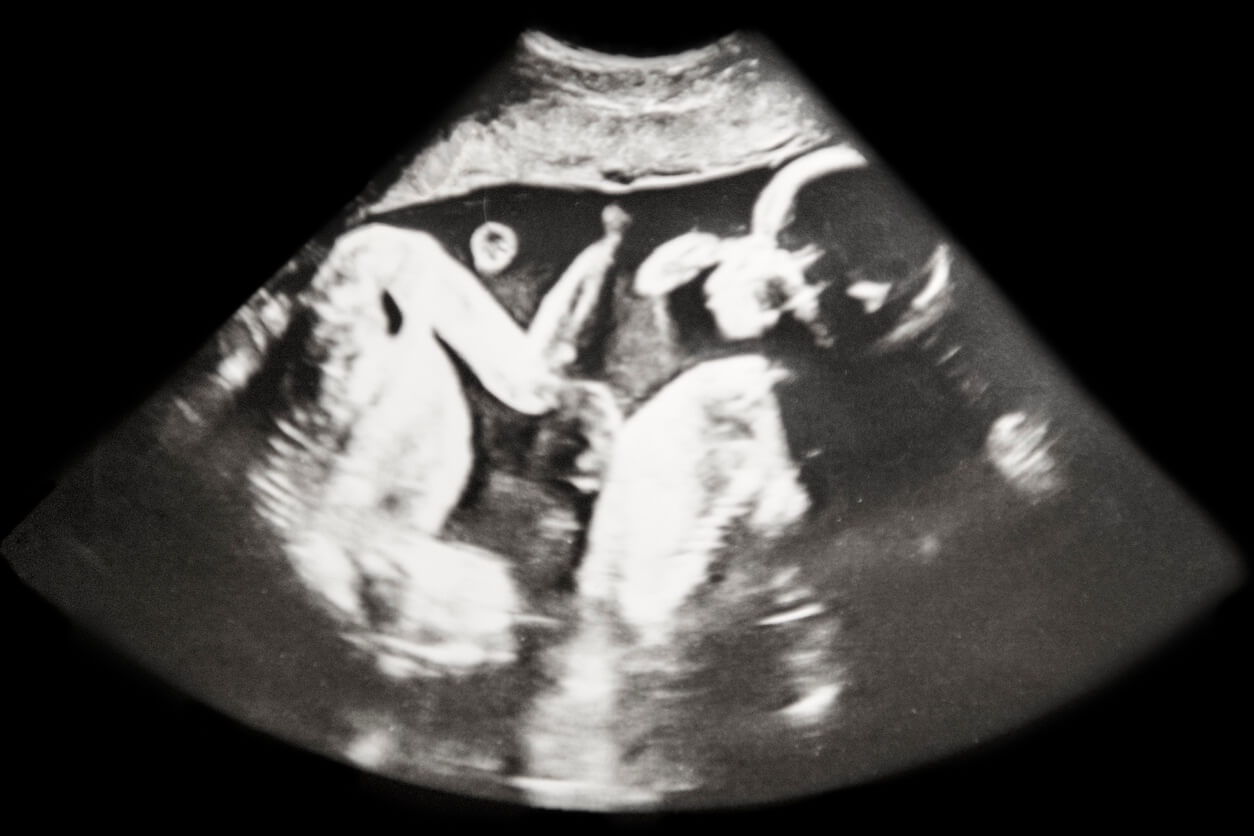What Is Non-Invasive Prenatal Testing and What Does It Detect?


Written and verified by the nurse Leidy Mora Molina
One of the scientific advances in reproductive medicine is non-invasive prenatal testing. It’s a test in which chromosomal alterations are detected without the need to expose the fetus to complicated and risky diagnostic tests.
Through an analysis of a maternal blood sample, from the tenth week of pregnancy, the mother can know if the baby has any genetic abnormality. For example, it detects the probability of the baby having a disorder such as Down Syndrome or Edward’s Syndrome, as well as other chromosomal microdeletions. But how reliable is this test and when should it be performed? We’ll tell you all you need to know in the following article.
Non-invasive prenatal testing
From the beginning of pregnancy, there are many expectations about the formation and growth of the baby. Especially when there are factors that increase the risk of genetic issues.
In the past, detecting these fetal anomalies required invasive tests in which genetic material was taken directly from the placenta or amniotic fluid. However, non-invasive prenatal testing is now performed as the first test to avoid the risks involved in these other procedures.
In this test, fetal DNA found in the maternal bloodstream is detected, which makes evaluating the probability of chromosomal alterations in the baby possible. However, this procedure doesn’t diagnose abnormalities, but rather indicates the probability of a baby’s risk of suffering from them. For this reason, if the results are abnormal, an invasive diagnostic test is ordered to confirm it.
It should be noted that the non-invasive prenatal test offers a 99% detection rate for trisomy 21 and Down syndrome, as well as a 95% rate for trisomies 13 and 18.

When is non-invasive prenatal testing recommended?
Non-invasive prenatal testing isn’t common in pregnant women. In order for a specialist to indicate it, the mother must have some conditions that heighten the child’s risk of suffering from chromosomal alterations. Among these we can highlight the following:
- Elderly women
- Family history of chromosomal abnormalities
- Previous pregnancy with trisomy
- When the first-trimester prenatal screening has indicated an intermediate risk, i.e., between 1/270 and 1/1000
- Mothers who wish to have this test even if they don’t have associated risk factors
When should the test be performed?
Non-invasive prenatal testing should be performed from week 10 onwards. This is because, before this stage, there’s very little fetal material in the maternal bloodstream. In twin pregnancies, this test should be performed at 12 weeks.
To perform the test, there are several analytical techniques, such as the study of circulating fetal cells in maternal blood, free fetal DNA circulating in maternal blood, and fetal mRNA circulating in maternal blood. The one used most commonly is the first, in which the baby’s DNA is isolated using molecular biology techniques for subsequent analysis.
How is it performed?
To perform non-invasive prenatal testing, first of all, an ultrasound is performed to confirm gestational age and rule out possible conditions that may affect the results of the test. Then, the peripheral blood sample is ordered for the mother.
Once a tourniquet is placed at the top to allow visualization of the veins and asepsis of the area is performed, blood is drawn from the basilic or cephalic vein of the arm. For this, the needle is introduced and a sample of approximately 20 ml is taken. Then, pressure is applied to the puncture area. It’s not usually a painful procedure. The results are delivered in approximately 5 days.
What does non-invasive prenatal testing detect?
This test detects the probability of a baby having genetic abnormalities, but it does not detect malformations. Therefore, information such as the sex of the baby, the fetal Rh group, the number of X and Y sex chromosomes, and fetal genetic disorders can be obtained. Regarding the latter, the detects risk regarding between 5 and 6 chromosomal disorders and also other diseases related to microdeletions. Among these, we can mention the following:
- Trisomy 21 or Down syndrome.
- Trisomy 18 or Edwards syndrome.
- Trisomy 13 or Patau syndrome.
- Other microdeletions: These occur when there’s the absence of a small fragment of a chromosome that causes some disorders, such as Prader-Willi syndrome.

Under what conditions is noninvasive prenatal testing contraindicated?
There are conditions in which this test shouldn’t be performed because it doesn’t offer conclusive results. These include the following:
- Before the tenth week of gestation
- Blood transfusion within the last six months
- Placental hematoma
- Recent bone marrow transplant
- When a baby has been lost in a twin pregnancy
- Obesity or weight greater than 200 pounds
Non-invasive prenatal test results
When the results of the non-invasive prenatal test are abnormal, the specialist will request other diagnostic tests, such as amniocentesis or chorionic villus sampling. Certainly, a mother needs to know as soon as possible whether her baby is healthy or has a chromosomal abnormality. This way, she’ll be able to receive guidance from genetic doctors, in addition to scheduling delivery and postnatal care.
Non-invasive prenatal testing is ideal for the early detection of trisomies and microdeletions. In addition, it poses no risk to the mother or the baby, and the results are fast and highly reliable. If you have any doubts about this test, you should discuss them with the medical personnel you trust.
One of the scientific advances in reproductive medicine is non-invasive prenatal testing. It’s a test in which chromosomal alterations are detected without the need to expose the fetus to complicated and risky diagnostic tests.
Through an analysis of a maternal blood sample, from the tenth week of pregnancy, the mother can know if the baby has any genetic abnormality. For example, it detects the probability of the baby having a disorder such as Down Syndrome or Edward’s Syndrome, as well as other chromosomal microdeletions. But how reliable is this test and when should it be performed? We’ll tell you all you need to know in the following article.
Non-invasive prenatal testing
From the beginning of pregnancy, there are many expectations about the formation and growth of the baby. Especially when there are factors that increase the risk of genetic issues.
In the past, detecting these fetal anomalies required invasive tests in which genetic material was taken directly from the placenta or amniotic fluid. However, non-invasive prenatal testing is now performed as the first test to avoid the risks involved in these other procedures.
In this test, fetal DNA found in the maternal bloodstream is detected, which makes evaluating the probability of chromosomal alterations in the baby possible. However, this procedure doesn’t diagnose abnormalities, but rather indicates the probability of a baby’s risk of suffering from them. For this reason, if the results are abnormal, an invasive diagnostic test is ordered to confirm it.
It should be noted that the non-invasive prenatal test offers a 99% detection rate for trisomy 21 and Down syndrome, as well as a 95% rate for trisomies 13 and 18.

When is non-invasive prenatal testing recommended?
Non-invasive prenatal testing isn’t common in pregnant women. In order for a specialist to indicate it, the mother must have some conditions that heighten the child’s risk of suffering from chromosomal alterations. Among these we can highlight the following:
- Elderly women
- Family history of chromosomal abnormalities
- Previous pregnancy with trisomy
- When the first-trimester prenatal screening has indicated an intermediate risk, i.e., between 1/270 and 1/1000
- Mothers who wish to have this test even if they don’t have associated risk factors
When should the test be performed?
Non-invasive prenatal testing should be performed from week 10 onwards. This is because, before this stage, there’s very little fetal material in the maternal bloodstream. In twin pregnancies, this test should be performed at 12 weeks.
To perform the test, there are several analytical techniques, such as the study of circulating fetal cells in maternal blood, free fetal DNA circulating in maternal blood, and fetal mRNA circulating in maternal blood. The one used most commonly is the first, in which the baby’s DNA is isolated using molecular biology techniques for subsequent analysis.
How is it performed?
To perform non-invasive prenatal testing, first of all, an ultrasound is performed to confirm gestational age and rule out possible conditions that may affect the results of the test. Then, the peripheral blood sample is ordered for the mother.
Once a tourniquet is placed at the top to allow visualization of the veins and asepsis of the area is performed, blood is drawn from the basilic or cephalic vein of the arm. For this, the needle is introduced and a sample of approximately 20 ml is taken. Then, pressure is applied to the puncture area. It’s not usually a painful procedure. The results are delivered in approximately 5 days.
What does non-invasive prenatal testing detect?
This test detects the probability of a baby having genetic abnormalities, but it does not detect malformations. Therefore, information such as the sex of the baby, the fetal Rh group, the number of X and Y sex chromosomes, and fetal genetic disorders can be obtained. Regarding the latter, the detects risk regarding between 5 and 6 chromosomal disorders and also other diseases related to microdeletions. Among these, we can mention the following:
- Trisomy 21 or Down syndrome.
- Trisomy 18 or Edwards syndrome.
- Trisomy 13 or Patau syndrome.
- Other microdeletions: These occur when there’s the absence of a small fragment of a chromosome that causes some disorders, such as Prader-Willi syndrome.

Under what conditions is noninvasive prenatal testing contraindicated?
There are conditions in which this test shouldn’t be performed because it doesn’t offer conclusive results. These include the following:
- Before the tenth week of gestation
- Blood transfusion within the last six months
- Placental hematoma
- Recent bone marrow transplant
- When a baby has been lost in a twin pregnancy
- Obesity or weight greater than 200 pounds
Non-invasive prenatal test results
When the results of the non-invasive prenatal test are abnormal, the specialist will request other diagnostic tests, such as amniocentesis or chorionic villus sampling. Certainly, a mother needs to know as soon as possible whether her baby is healthy or has a chromosomal abnormality. This way, she’ll be able to receive guidance from genetic doctors, in addition to scheduling delivery and postnatal care.
Non-invasive prenatal testing is ideal for the early detection of trisomies and microdeletions. In addition, it poses no risk to the mother or the baby, and the results are fast and highly reliable. If you have any doubts about this test, you should discuss them with the medical personnel you trust.
All cited sources were thoroughly reviewed by our team to ensure their quality, reliability, currency, and validity. The bibliography of this article was considered reliable and of academic or scientific accuracy.
- Gonzales, F. (2011) Diagnóstico prenatal genético no invasivo: reflexión bioética sobre la utilización del diagnóstico prenatal no invasivo a partir del análisis de ácidos nucleicos presentes en sangre periférica materna. Cuadernos de Bioética, vol. XXII, núm. 1, enero-abril, 2011, pp. 49-75 Asociación Española de Bioética y Ética Médica.
- Hernández, M. (2015). Prueba prenatal no invasiva (NIPT) en sangre materna a través de secuenciación masiva paralela (MPS). Experiencia inicial en mujeres mexicanas y revisión de la bibliografía. Revista de Ginecología y Obstetricia Mexicana 2015;83:277-288.
- Illanes, S. (2014). Diagnóstico prenatal no invasivo. Revista Médica Clínica Condes 2014; 25(6) 864-864]. Recuperado de: https://www.researchgate.net/publication/273835245_Diagnostico_prenatal_no_invasivo
- Rosas, I. (2017). Diagnostico prenatal no invasivo. Sociedad española de medicina de laboratorio. Educación Continua en el Laboratorio Clínico; 28: 88-100.
This text is provided for informational purposes only and does not replace consultation with a professional. If in doubt, consult your specialist.








